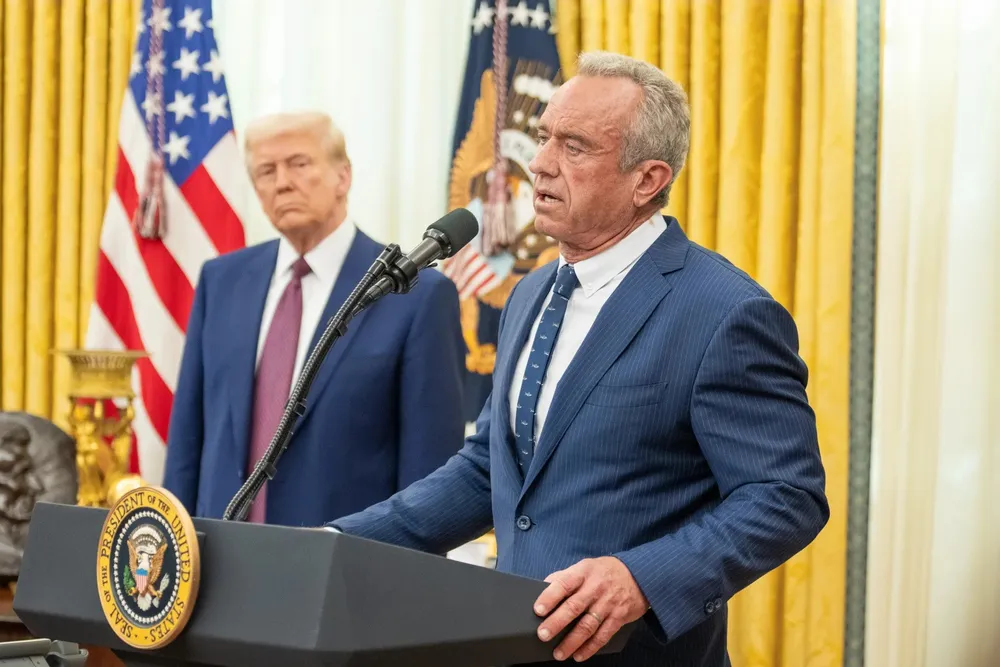Trump team all in on killing US offshore wind: cabinet secretary
DHHS' Robert Kennedy Jr. repeats litany of falsehoods against industry in confirming administration's intent

In further sign that Team Trump isn’t letting facts interfere with energy policy, at a recent Cabinet meeting secretary of Health and Human Services (DHHS) Robert F. Kennedy issued a litany of falsehoods against offshore wind that apparently underpin the administration’s approach to the industry.
Kennedy, notorious for his anti-vaccine positions during the Covid pandemic, seems to be spearheading President Donald Trump’s drive to kill offshore wind.
“We now have an inter-departmental coalition team, which is Doug Burgum (secretary of the Interior) and Howard Lutnick (secretary of Commerce) and Chris Wright (secretary of Energy) and Pete Hegseth (secretary of Defence),” Kennedy said, adding secretary of Education Linda McMahon.
“We're all working together on this issue,” Kennedy said.
Former President Joe Biden’s administration approved 11 projects totalling 19GW, which Kennedy and his colleagues aim to derail.
Trump has already issued multiple executive orders aimed at stopping the industry, which now expects only the five arrays currently in advanced construction amounting to less than 6GW to be completed over the next four years.
However, even this was shattered this week when Trump issued a sudden stop-work order against Orsted’s 704MW Revolution Wind array that is already 80% complete.
Kennedy's misstatements ranged from trivial to highly consequential.
He said that offshore wind “towers are twice the size of the Washington Monument.”
In fact, the Washington Monument in Washington, DC, stands at 169 metres, while the height of a turbine at US flagship array Vineyard Wind measured from ocean surface to blade tip is 260 metres.
The DHHS secretary referenced a blade failure at Vineyard last summer, saying: “They had to close the beaches, but they haven't identified themselves, so the local communities can't sue them.”
Nantucket and GE Vernova, turbine supplier to Vineyard, just settled litigation with a $10m payoff to the island off Massachusetts.
Kennedy’s grasp of costs was likewise challenged.
Sector costs
“The cost of energy from these projects is 39 cents a kilowatt hour,” Kennedy said. “The average cost in this country is 17 cents per kilowatt hour.”
Trump interjected: “And natural gas is three cents.”
According to the National Renewable Energy Laboratory (NREL) under the Department of Energy (DoE), offshore wind costs spiralled to reach levelized cost of energy (LCOE) of around $117/MWh – not $390/MWh, as claimed by Kennedy.
The DHHS secretary was correct in stating the average power price in the US in June, according to the Energy Information Administration (EIA), was $170/MWh.
Natural gas-fired power varies considerably due to the fuel supply and demand.
Combined cycle plants average $39~68/MWh, higher than Trump’s estimated $30/MWh, while simple cycle peaker plants ranged from $110/MWh to $200/MWh, according to the EIA.
The DHHS secretary continued to repeat claims made by fisheries and some environmentalists that wind farms are “wiping out the whale population” and that “fisheries are being wiped out as soon as they begin construction.”
Decommissioning
Kennedy bumped into one issue that is of concern: decommissioning.
“None of these projects are bonded,” Kennedy claimed. “If you build an oil derrick in the Gulf, you got to put a bond down. There's no bond for dismantling them, and that's one of the tools that Doug [Burgum] is now using to challenge some of these projects,” he added.
US offshore wind has come under fire for what many see as lax financial assurances that projects will be removed at the end of their lease terms, typically 20-25 years.
The Government Accountability Office last year flagged coastal regulator Bureau of Ocean Energy Management's practices as potentially leaving some projects at risk of default before sufficient financial guarantees are in place.
Lease buyers were able to put up only $100,000 in bond at purchase time in an effort to defray early startup costs.
While additional financial assurances are required in construction and operations plans (COPs), decommissioning remains a concern, as it does for the oil & gas industry.